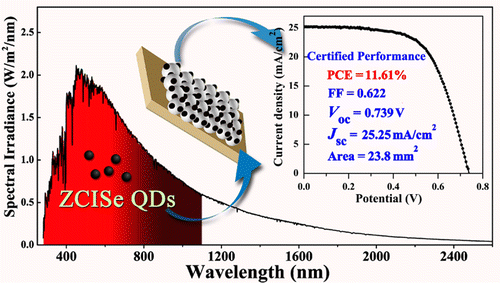Zn–Cu–In–Se Quantum Dot Solar Cells with a Certified Power Conversion Efficiency of 11.6%
Jun Du, Zhonglin Du, Jin-Song Hu, Zhenxiao Pan, Qing Shen, Jiankun Sun, Donghui Long, Hui Dong,Litao Sun, Xinhua Zhong, and Li-Jun Wan
J. Am. Chem. Soc., 2016, 138 (12), pp 4201–4209
DOI: 10.1021/jacs.6b00615
Publication Date (Web): March 10, 2016
Abstract (click for pdf file)

The enhancement of power conversion efficiency (PCE) and the development of toxic Cd-, Pb-free quantum dots (QDs) are critical for the prosperity of QD-based solar cells. It is known that the properties (such as light harvesting range, band gap alignment, density of trap state defects, etc.) of QD light harvesters play a crucial effect on the photovoltaic performance of QD based solar cells. Herein, high quality ~4 nm Cd-, Pb-free Zn–Cu–In–Se alloyed QDs with an absorption onset extending to ~1000 nm were developed as effective light harvesters to construct quantum dot sensitized solar cells (QDSCs). Due to the small particle size, the developed QD sensitizer can be efficiently immobilized on TiO2 film electrode in less than 0.5 h. An average PCE of 11.66% and a certified PCE of 11.61% have been demonstrated in the QDSCs based on these Zn–Cu–In–Se QDs. The remarkably improved photovoltaic performance for Zn–Cu–In–Se QDSCs vs Cu–In–Se QDSCs (11.66% vs 9.54% in PCE) is mainly derived from the higher conduction band edge, which favors the photogenerated electron extraction and results in higher photocurrent, and the alloyed structure of Zn–Cu–In–Se QD light harvester, which benefits the suppression of charge recombination at photoanode/electrolyte interfaces and thus improves the photovoltage.

